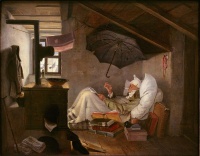Poetry
From The Art and Popular Culture Encyclopedia
(Difference between revisions)
| Revision as of 10:03, 30 December 2013 Jahsonic (Talk | contribs) ← Previous diff |
Revision as of 10:04, 30 December 2013 Jahsonic (Talk | contribs) Next diff → |
||
| Line 3: | Line 3: | ||
| [[Image:The Poor Poet by Carl Spitzweg.jpg|thumb|200px|''[[The Poor Poet]]'' (1839) is a painting by [[Carl Spitzweg]]]] | [[Image:The Poor Poet by Carl Spitzweg.jpg|thumb|200px|''[[The Poor Poet]]'' (1839) is a painting by [[Carl Spitzweg]]]] | ||
| {{Template}} | {{Template}} | ||
| - | '''Poetry''' (from the [[Greek language|Greek]] "ποίησις", ''[[poiesis]]'', a "making" or "[[creating]]") is a form of [[art]] in which [[language]] is used for its [[aesthetics|aesthetic]] and evocative qualities in addition to, or in lieu of, its ostensible [[meaning (linguistics)|meaning]]. Poetry may be written independently, as discrete poems, but since the dawn of [[mechanical reproduction]] of [[music]], is with us in the form of [[lyrics]] of [[song]]s. | + | |
| - | == History == | + | '''Poetry''' (from the [[Greek language|Greek]] ''[[poiesis]]'' — ποίησις — meaning a "making", seen also in such terms as "[[hemopoiesis|hemo''poiesis'']]"; more narrowly, the making of poetry) is a form of [[literature|literary art]] which uses [[aesthetics|aesthetic]] and rhythmic<!-- Please discuss on talk page before removing or altering this word. Dictionary definitions of "poetry" tend to include, in addition to the aesthetic quality of poetry, a structural/rhythmical/metrical quality as well. qualities of [[language]]—such as [[phonaesthetics]], [[sound symbolism]], and [[metre (poetry)|metre]]—to evoke meanings in addition to, or in place of, the [[Prose|prosaic]] ostensible [[meaning (linguistics)|meaning]]. |
| - | '''Poetry''' as an art form may have predated [[literacy]]. Some of the earliest [[poetry]] is believed to have been orally recited or sung. Following the development of [[writing]], poetry has since developed into increasingly structured forms, though much poetry since the late [[19th century]] has moved away from traditional forms towards the more vaguely defined [[free verse]] and [[prose poetry|prose poem]] formats. | + | |
| + | Poetry has a long [[history of poetry|history]], dating back to the [[Sumerian language|Sumerian]] ''[[Epic of Gilgamesh]]''. Early poems evolved from folk songs such as the Chinese ''[[Classic of Poetry|Shijing]]'', or from a need to retell oral epics, as with the [[Sanskrit literature|Sanskrit]] ''[[Vedas]]'', [[Zoroastrianism|Zoroastrian]] ''[[Gathas]]'', and the [[Homer]]ic epics, the ''[[Iliad]]'' and the ''[[Odyssey]]''. Ancient attempts to define poetry, such as [[Aristotle]]'s ''[[Poetics (Aristotle)|Poetics]]'', focused on the uses of [[Speech communication|speech]] in [[rhetoric]], [[drama]], [[song]] and [[comedy]]. Later attempts concentrated on features such as repetition, [[line (poetry)|verse form]] and [[rhyme]], and emphasized the aesthetics which distinguish poetry from more objectively-informative, [[prose|prosaic]] forms of writing. From the mid-20th century, poetry has sometimes been more generally regarded as a fundamental creative act employing language. | ||
| + | |||
| + | Poetry uses forms and conventions to suggest differential interpretation to words, or to evoke emotive responses. Devices such as [[assonance]], [[alliteration]], [[onomatopoeia]] and [[rhythm]] are sometimes used to achieve [[music]]al or [[incantation|incantatory]] effects. The use of [[ambiguity]], [[symbol]]ism, [[irony]] and other [[stylistics (linguistics)|stylistic]] elements of [[poetic diction]] often leaves a poem open to multiple interpretations. Similarly, [[metaphor]], [[simile]] and [[metonymy]] create a resonance between otherwise disparate images—a layering of meanings, forming connections previously not perceived. Kindred forms of resonance may exist, between individual [[Verse (poetry)|verse]]s, in their patterns of rhyme or rhythm. | ||
| + | |||
| + | Some poetry types are specific to particular [[culture]]s and [[genre]]s and respond to characteristics of the language in which the poet writes. Readers accustomed to identifying poetry with [[Dante Alighieri|Dante]], [[Johann Wolfgang von Goethe|Goethe]], [[Adam Mickiewicz|Mickiewicz]] and [[Rumi]] may think of it as written in [[Line (poetry)|lines]] based on [[rhyme]] and regular [[meter (poetry)|meter]]; there are, however, traditions, such as [[Biblical poetry]], that use other means to create rhythm and [[euphony]]. Much modern poetry reflects a critique of poetic tradition, In today's increasingly [[globalization|globalized]] world, poets often adapt forms, styles and techniques from diverse cultures and languages. | ||
| + | |||
| ==See also== | ==See also== | ||
| *[[Ut pictura poesis]] | *[[Ut pictura poesis]] | ||
Revision as of 10:04, 30 December 2013

Alle Weissheit ist bey Gott dem Herrn... (1654), informal title of a calligraphy of the Sirach by an anonymous artist
|
Related e |
|
Featured: |
Poetry (from the Greek poiesis — ποίησις — meaning a "making", seen also in such terms as "hemopoiesis"; more narrowly, the making of poetry) is a form of literary art which uses aesthetic and rhythmic



